11 Best Yanagiba Japanese Sushi Knives Reviewed
Yanagiba knives are one of the most popular types of Japanese kitchen knives. They are often used for slicing fish and other seafood, but can also be used for other types of cutting tasks.
The yanagiba is the ultimate sushi and sashimi knife!
There are a variety of different yanagiba knives available, so it can be tricky to know which one is right for you.
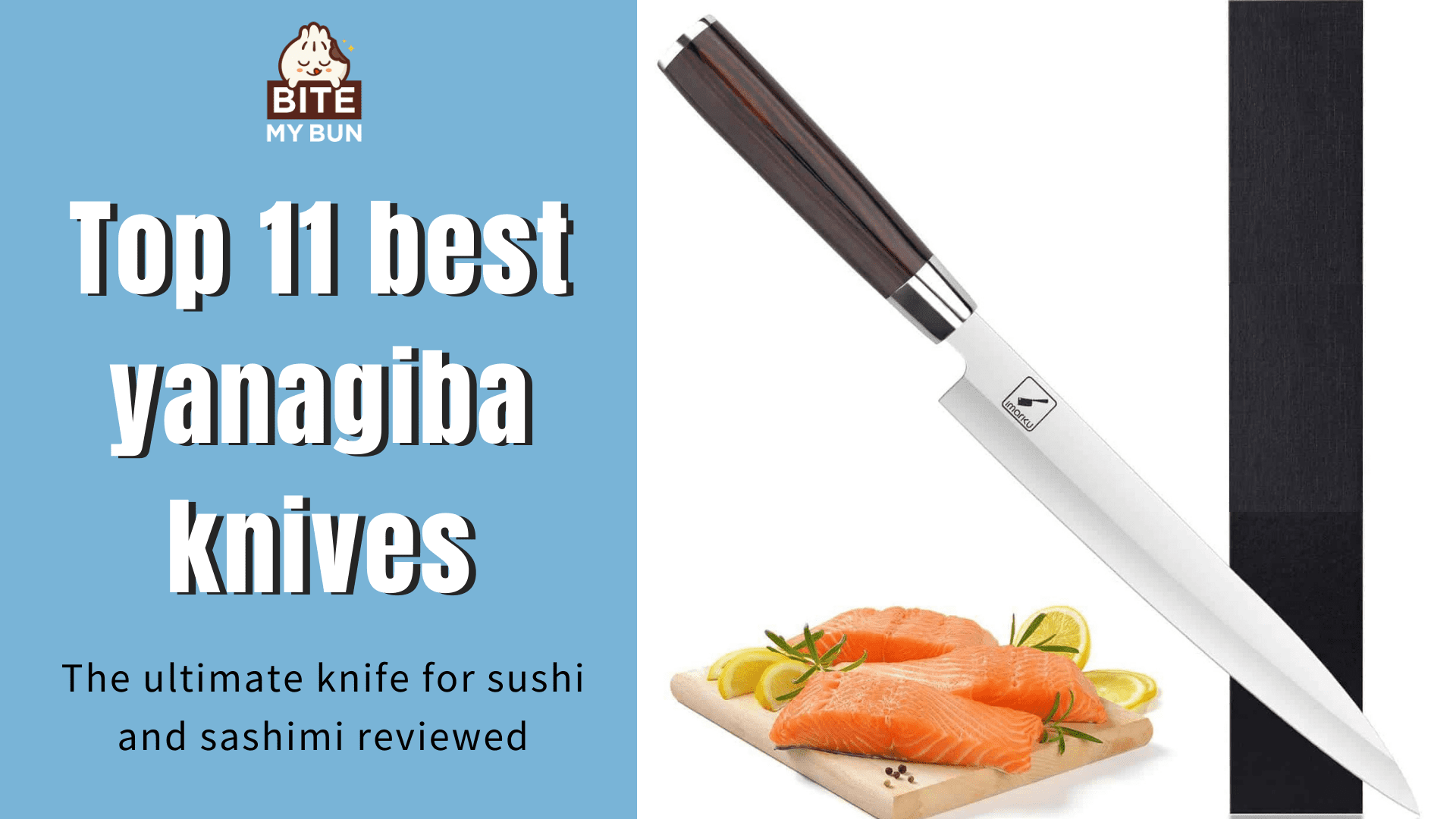
If you want a sharp knife you can maneuver easily with a sturdy blade and hygienic handle, the Imarku Yanagiba Knife ticks off all the boxes. It’s competitively priced and offers all the features of a premium product. You can use it to make sushi rolls or sashimi at home or at the restaurant.
In this post, I’ll introduce you to the different types of yanagiba knives and offer advice on which ones to pick. I’ll also review some of the best options on the market.
| Best yanagiba knife | Images |
|---|---|
| Best overall yanagiba knife: Imarku Professional Single Bevel Sushi Knife | 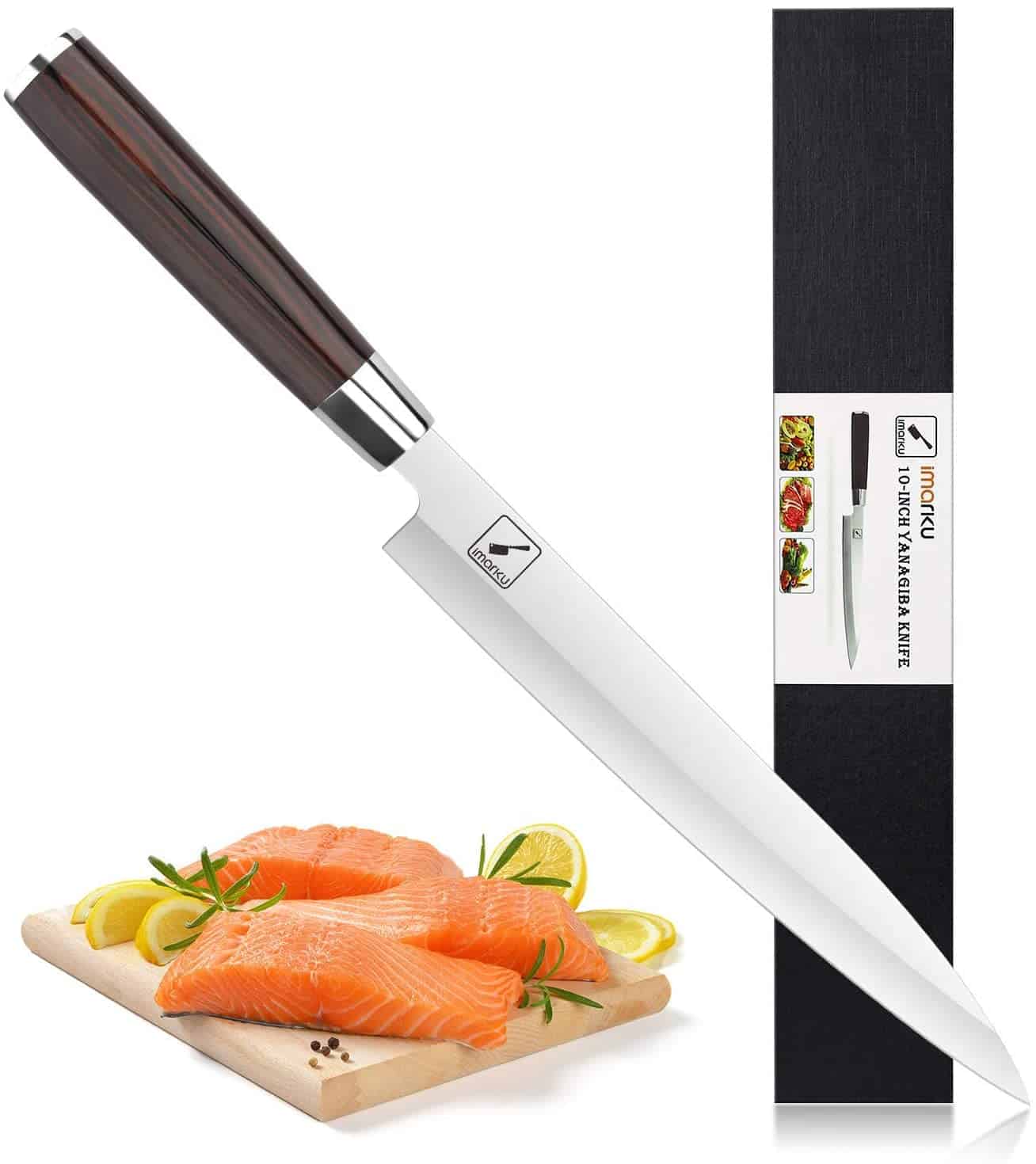 |
| Best budget yanagiba knife: KYOKU Samurai Series 10.5″ | 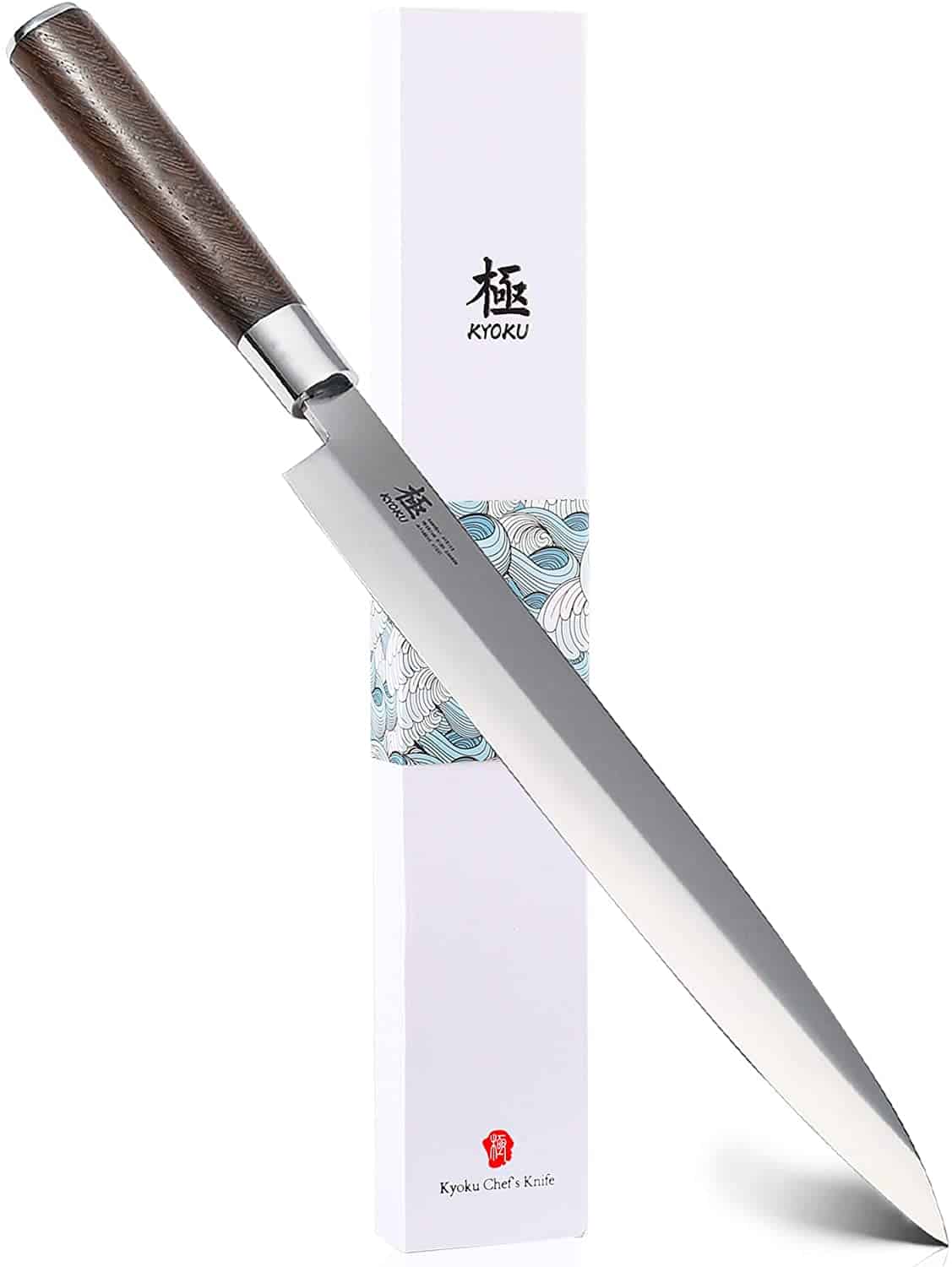 |
| Best yanagiba knife for chefs: DALSTRONG 9.5 inch Single-Bevel Blade | 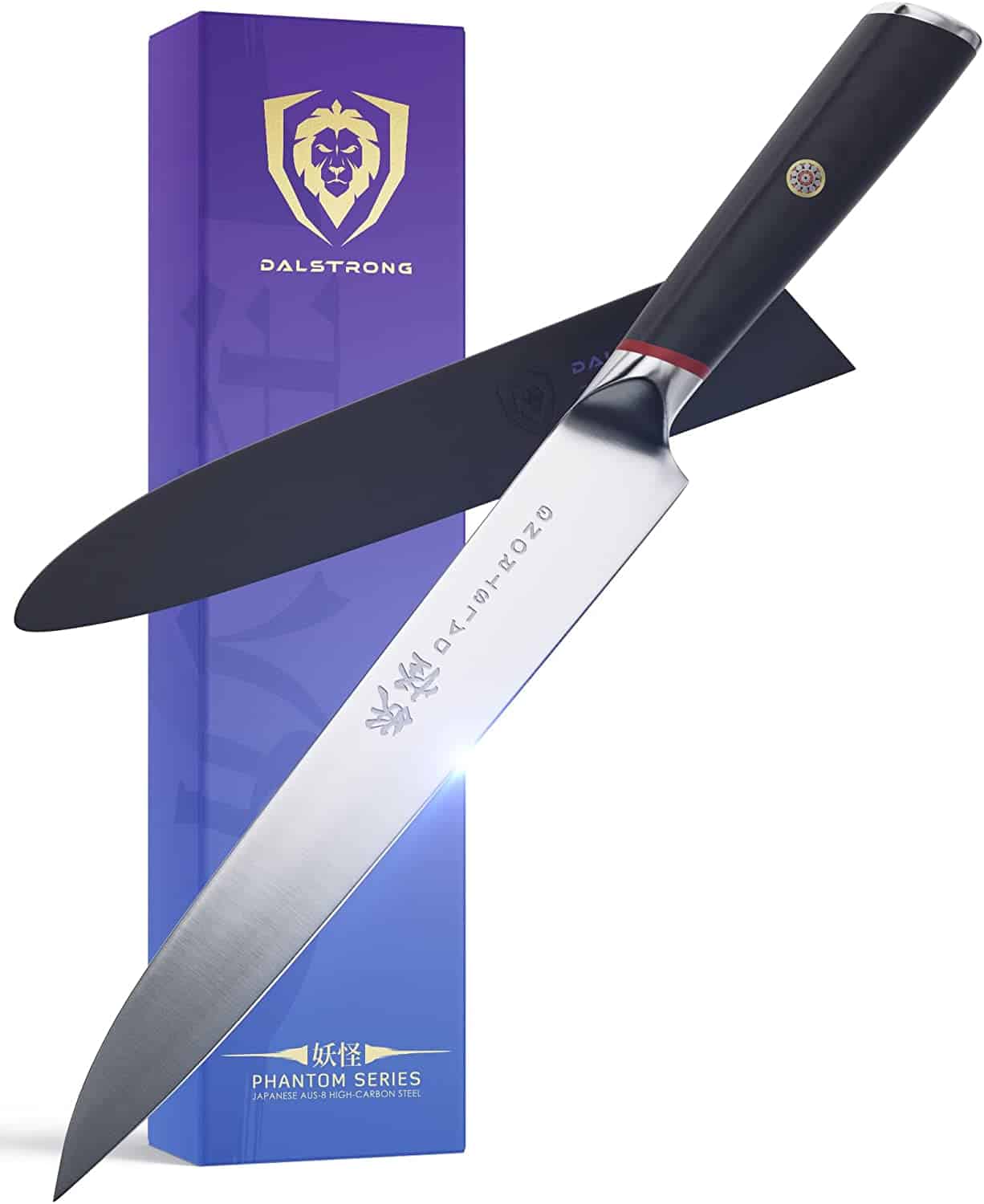 |
| Best value yanagiba knife: KEEMAKE Japanese VG10 Stainless Steel | 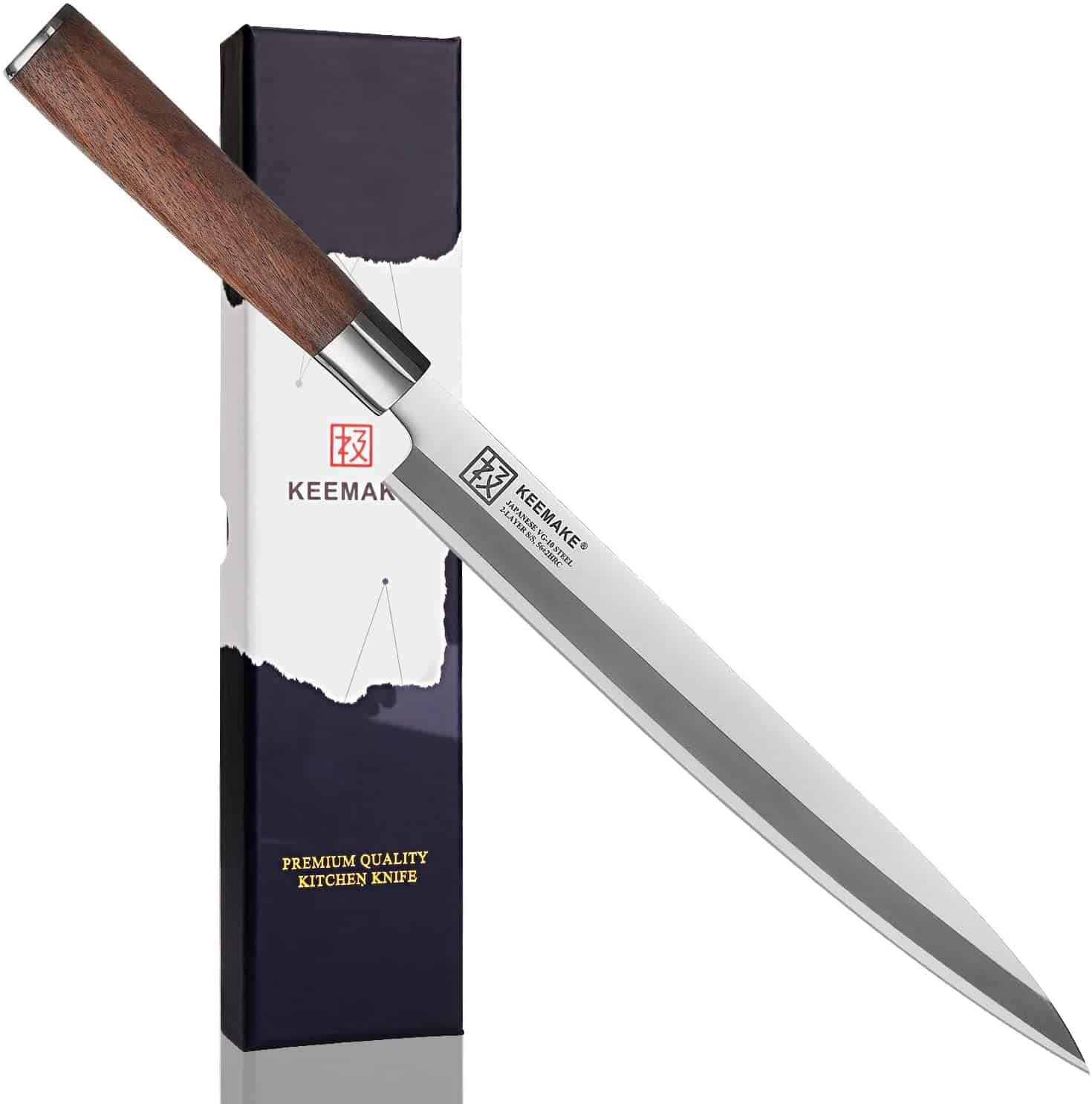 |
| Best yanagiba knife with hammered finish: YOUSUNLONG Fillet knife 12 inch Max | 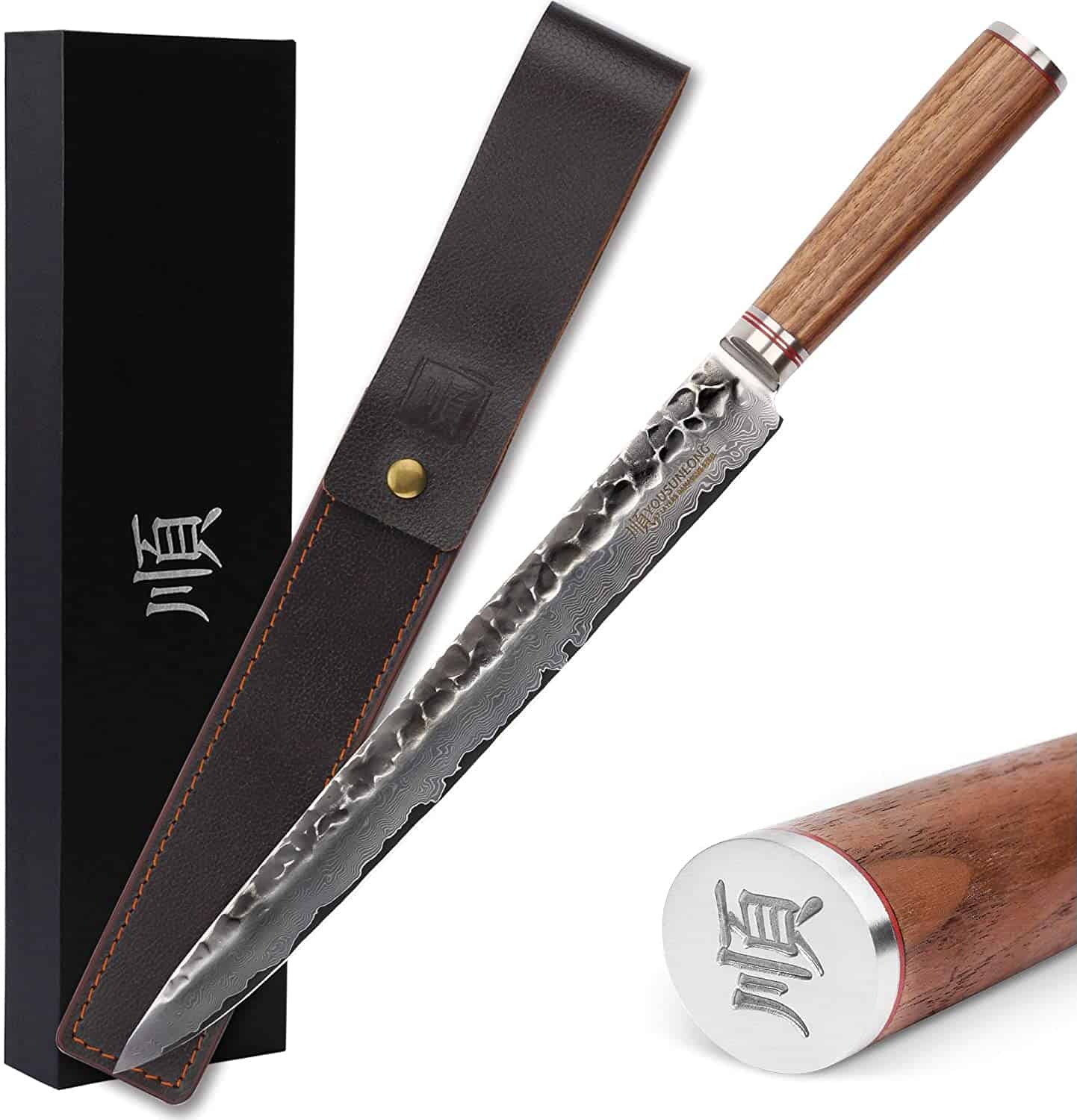 |
| Best yanagiba knife for beginners: TUO Sashimi Sushi | 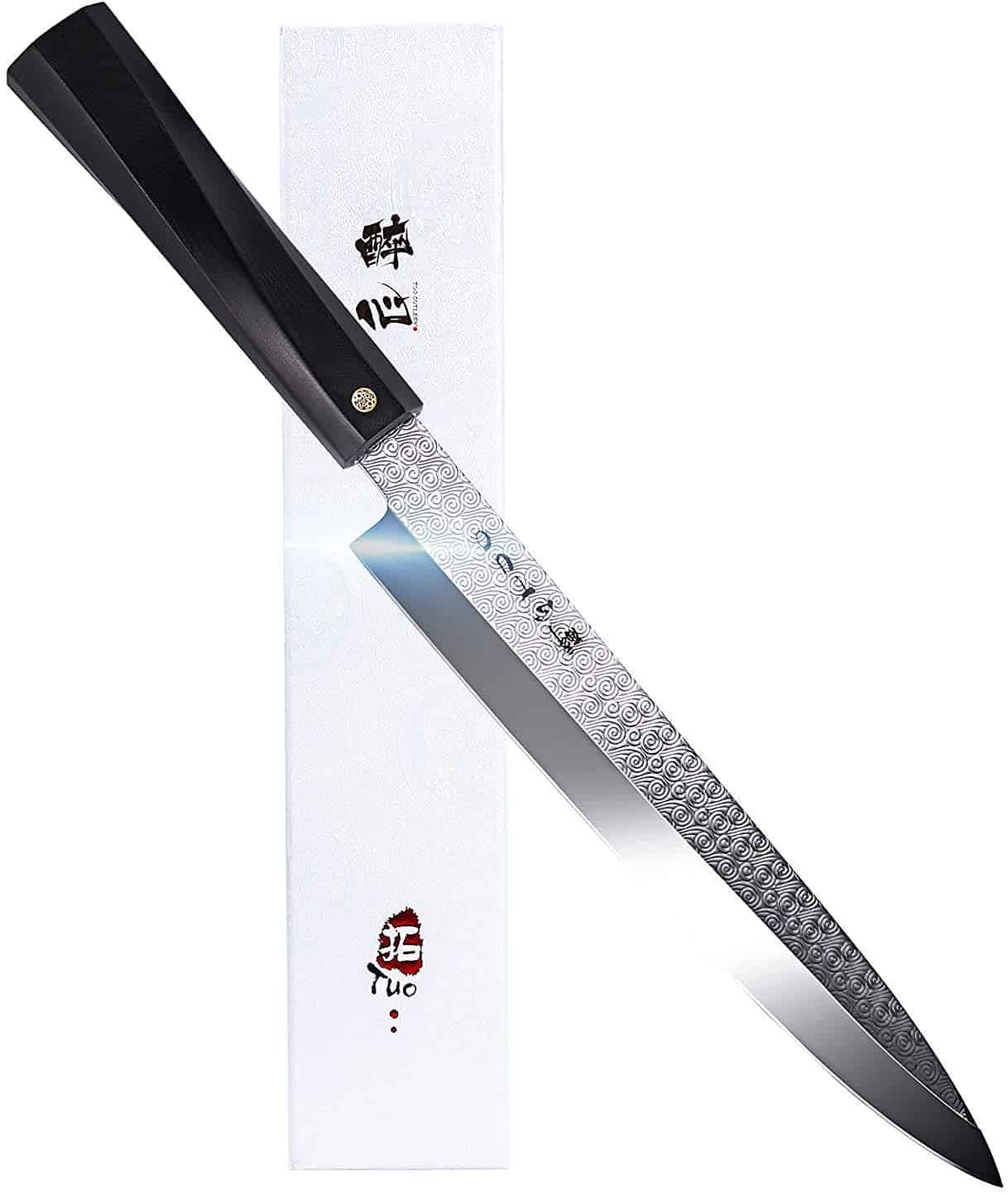 |
| Best double-bevel yanagiba knife: DALSTRONG Shadow Black Series Sushi Knife 10.5″ | 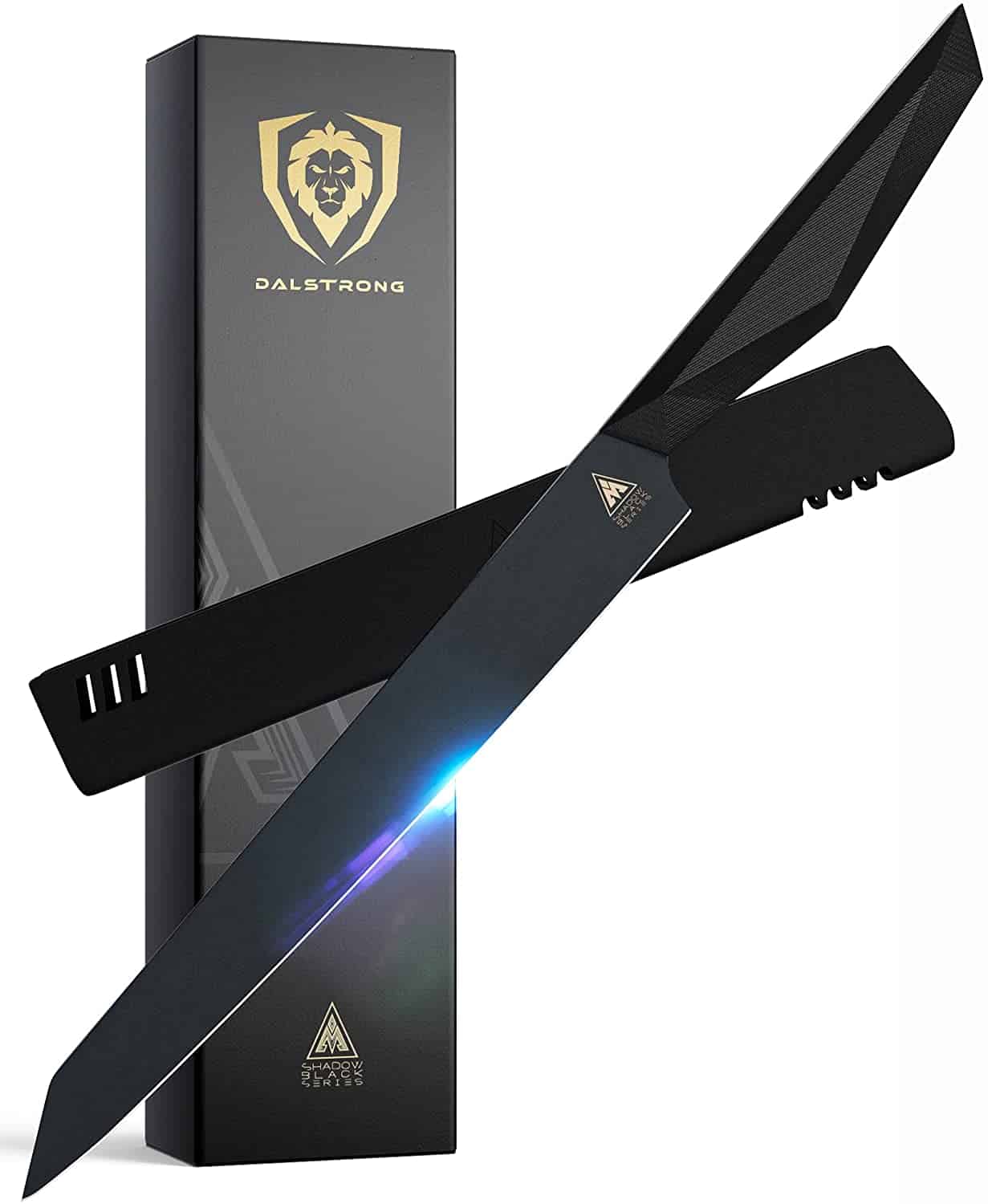 |
| Best yanagiba knife for left-handed users: Mercer Culinary Genesis Forged | 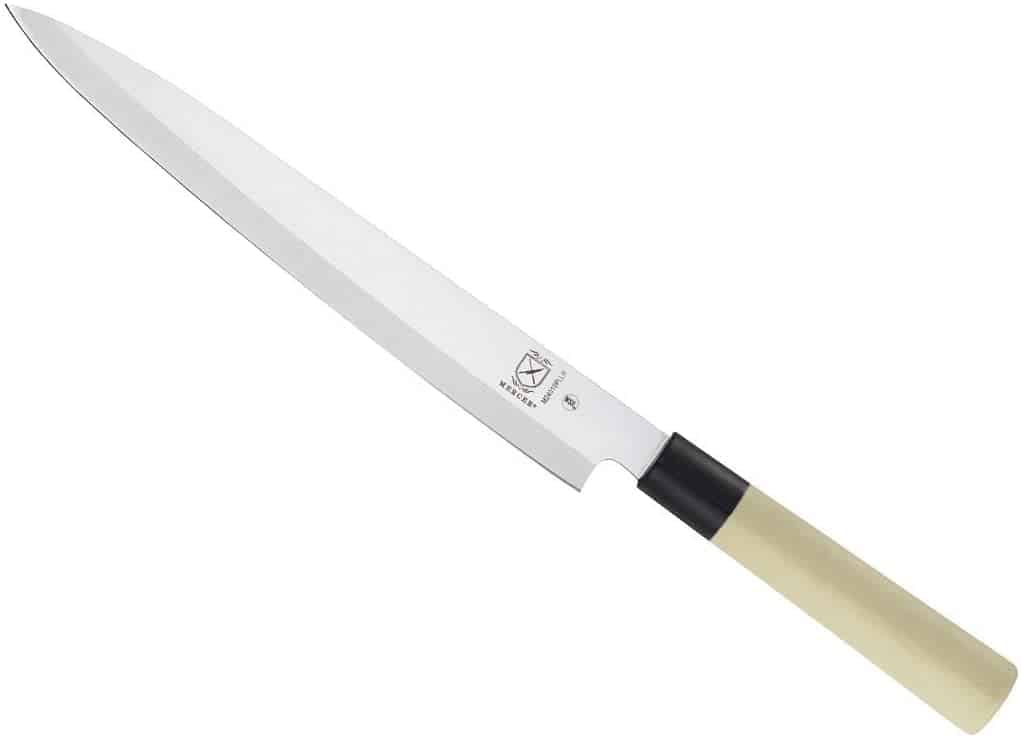 |
| Best premium yanagiba knife: MOTOKANE” Shirogami Steel Sashimi Hocho |  |
| Best yanagiba knife for sashimi: Sakai Takayuki Hammered Damascus | 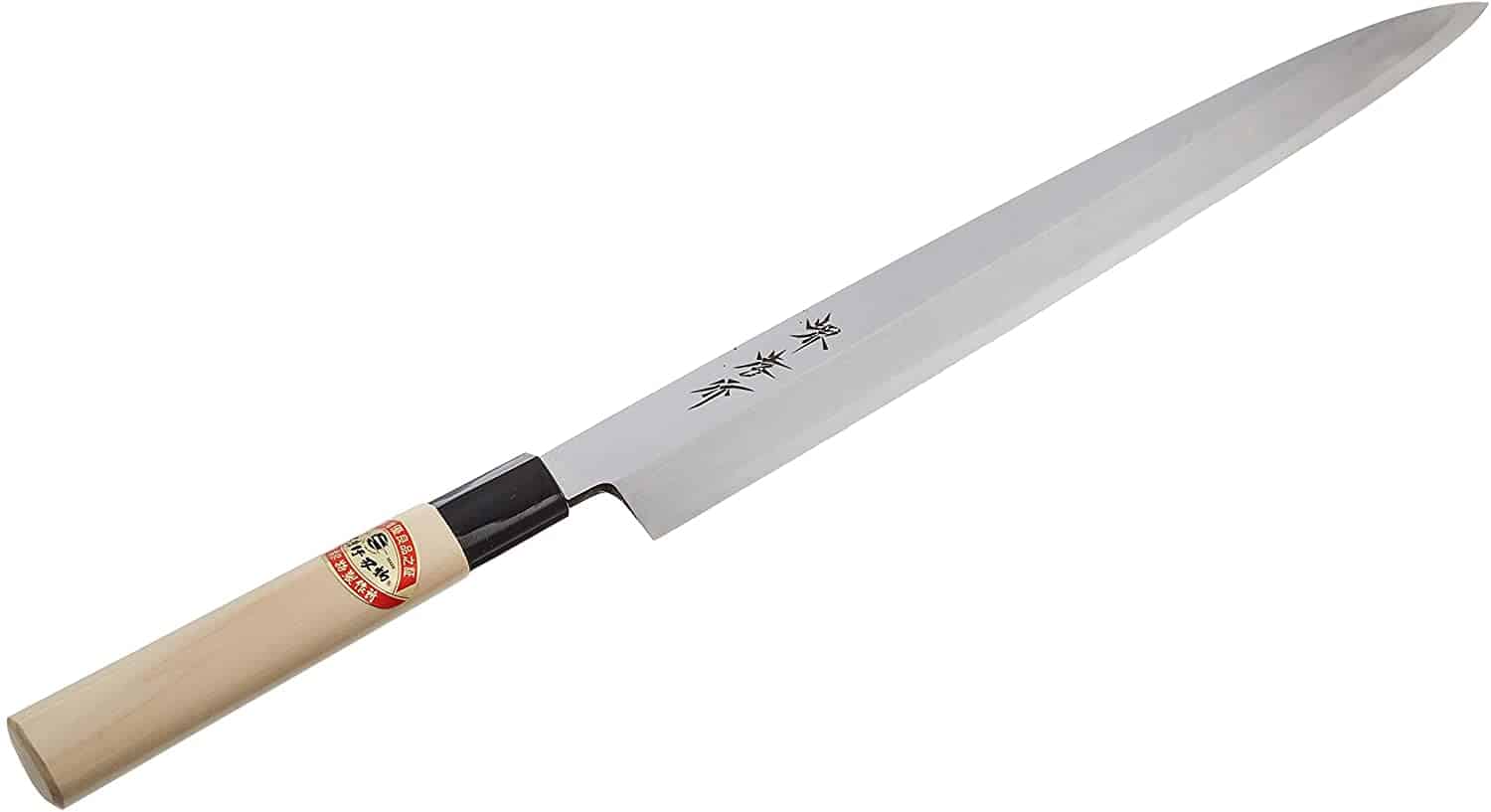 |
| Best yanagiba sushi knife with holes: JapanBargain 1551 Non-Stick Sashimi Knife | 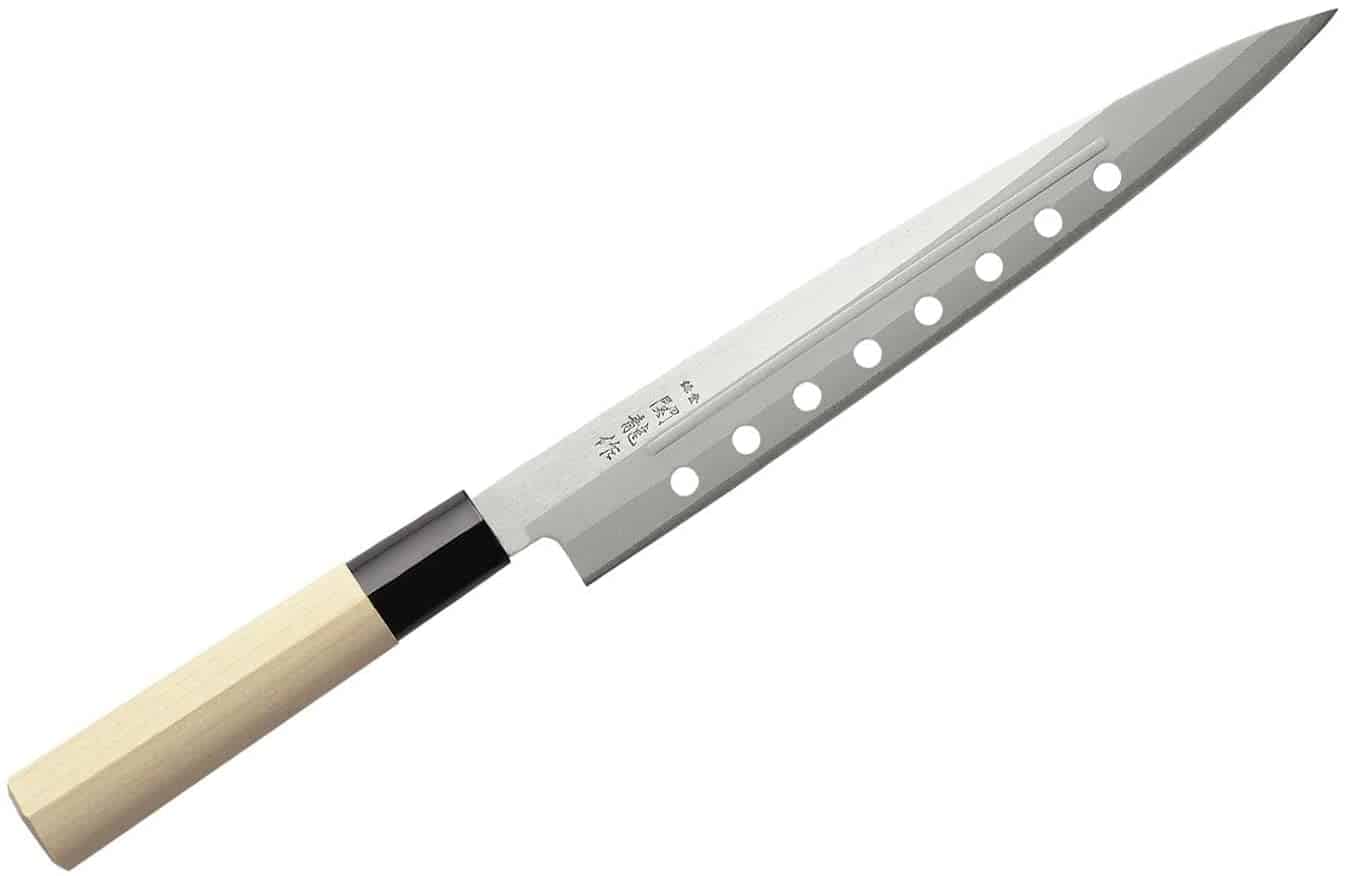 |

Check out our new cookbook
Bitemybun's family recipes with complete meal planner and recipe guide.
Try it out for free with Kindle Unlimited:
Read for freeIn this post we'll cover:
- 1 Buying guide for the best yanagiba knife
- 2 Review of the best yanagiba knives
- 2.1 Best overall yanagiba knife: Imarku Professional Single Bevel Sushi Knife
- 2.2 Best budget yanagiba knife: KYOKU Samurai Series 10.5″
- 2.3 Best yanagiba knife for chefs: DALSTRONG 9.5 inch Single-Bevel Blade
- 2.4 Best value yanagiba knife: KEEMAKE Japanese VG10 Stainless Steel
- 2.5 Best yanagiba knife with hammered finish: YOUSUNLONG Fillet knife 12 inch Max
- 2.6 Best yanagiba knife for beginners: TUO Sashimi Sushi
- 2.7 Best double-bevel yanagiba knife: DALSTRONG Shadow Black Series Sushi Knife 10.5″
- 2.8 Best yanagiba knife for left-handed users: Mercer Culinary Genesis Forged
- 2.9 Best premium yanagiba knife: MOTOKANE” Shirogami Steel Sashimi Hocho
- 2.10 Best yanagiba knife for sashimi: Sakai Takayuki Hammered Damascus
- 2.11 Best yanagiba sushi knife with holes: JapanBargain 1551 Non-Stick Sashimi Knife
- 3 Takeaway
Buying guide for the best yanagiba knife
When looking for a yanagiba knife to buy, there are certain features you want to pay attention to.
Here are the most important things to look for and then I’ll explain each feature separately.
- The blade should be sharp and made of high-quality steel
- The knife should be easy to sharpen
- The handle should feel comfortable in your hand
- The blade should be thin and flexible
Type
There are two main types of yanagiba knives:
- The Western yanagiba knife: This type of yanagiba knife has a shorter blade and is heavier than the Japanese version. It is designed for slicing meat and fish.
- The Japanese yanagiba knife: This type of yanagiba knife has a longer blade and is lighter than the Western version. It is designed for slicing fish.
But, yanagiba is also called a sushi knife or sashimi knife. So, although a product is called a sushi knife doesn’t mean that it’s not also a form of yanagiba knife.
In this review, I’m including a mix of both to suit everyone’s needs.
Blade length
Yanagiba knives are available in a range of different blade lengths. The most common blade lengths are 240mm, 270mm, and 300mm.
The best blade length for you depends on your needs. If you’re looking for a knife that is easy to control, then I would recommend a shorter blade.
But, if you’re looking for a knife that can handle larger cutting tasks, then I would recommend a longer blade.
Bevel
The traditional yanagiba knife is a single bevel, meaning that it’s sharpened on one side only. This creates a very sharp blade that is perfect for slicing fish.
However, some people prefer a double bevel yanagiba knife, which is sharper but also more prone to chipping.
Only western-style yanagiba have a double-edge so they are harder to find and not ‘true’ yanagiba if you ask master sushi chefs.
Blade material
Yanagiba knives are typically made from carbon steel or stainless steel. Carbon steel knives are sharper and easier to sharpen, but they are also more susceptible to rusting.
Stainless steel knives are not as sharp, but they are more durable and require less maintenance.
The best type of yanagiba knife to buy depends on your needs and preferences. If you’re looking for a knife that is easy to care for, then I would recommend a stainless steel knife.
But, if you’re looking for the sharpest possible blade, then I would recommend a carbon steel knife.
Learn all about the difference between white steel (aogami) and blue steel (shirogami) here
Handle material
Some yanagiba knives have a Western-style handle, while others have a traditional Japanese-style handle.
The handles of yanagiba knives are typically made from wood, plastic, or metal. Wood handles are the most traditional option and offer the best grip.
Plastic handles are the most common type of handle and are also very comfortable to hold. Metal handles are less common, but they offer the best durability.
Again, it’s important to choose a handle material that suits your needs and preferences. If you’re looking for a traditional knife, then I would recommend a wood handle.
Alternatively, if you’re looking for a durable knife, then I would recommend a metal, rubber, resin, or composite handle.
Review of the best yanagiba knives
I know that choosing a yanagi knife can be overwhelming but it comes down to budget and what kind of material you prefer.
Best overall yanagiba knife: Imarku Professional Single Bevel Sushi Knife
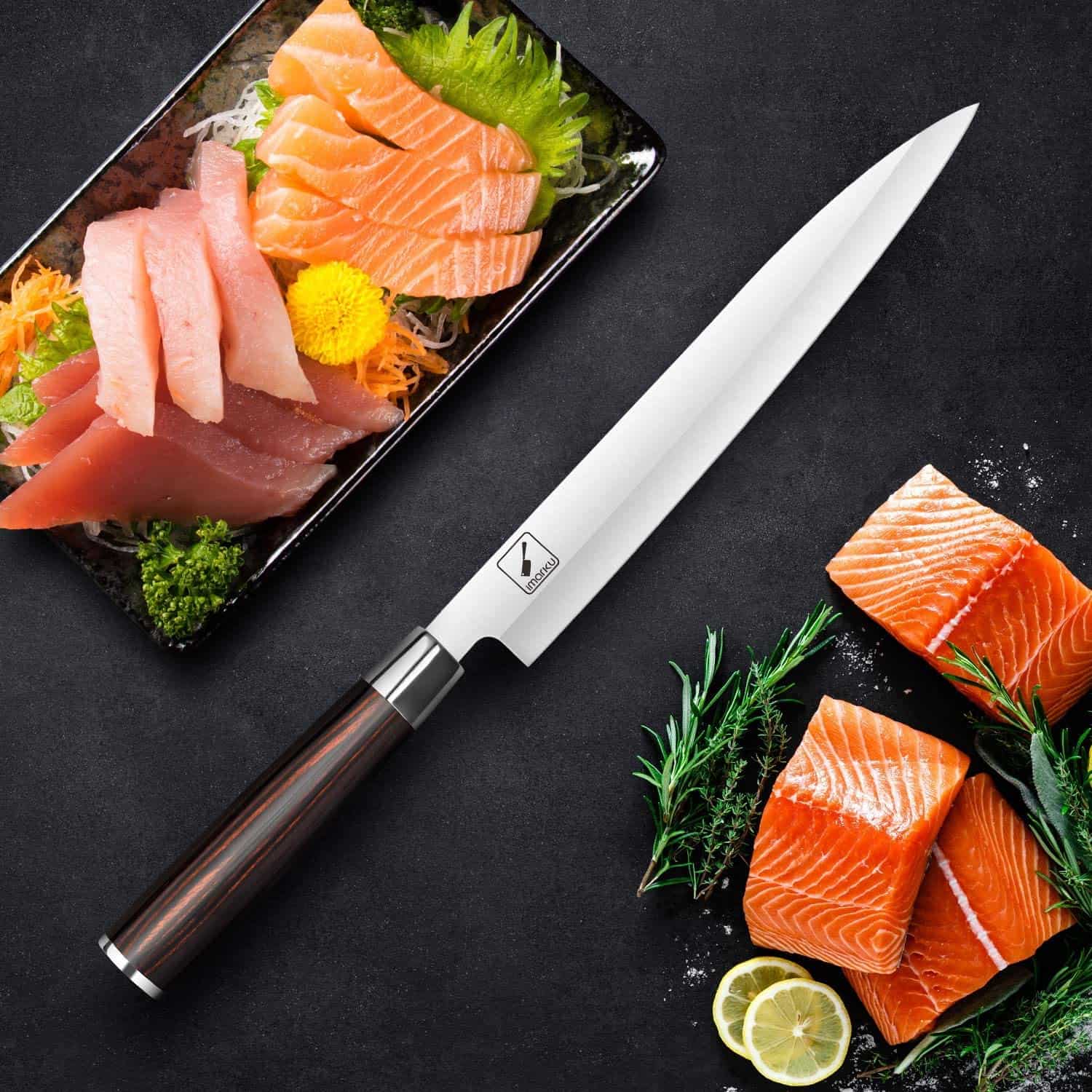
- blade length: 10 inches
- blade material: High-Carbon stainless steel
- bevel: single
- handle: pakkawood
If you’re looking for a professional-grade yanagiba knife that stays sharp for longer and has a traditional Japanese design, the Imarku 10″ blade is the top choice.
Imarku is the mid-priced knife brand you need to get your hands on. This knife is suitable for home cooks and sushi chefs alike because it has all the features of a premium Japanese knife.
This knife is well-known for its long-lasting performance. The blade of the knife can stay sharp for a long period without rusting. Because of this, it is the best sushi sashimi or yanagiba knife.
The blade is polished at 12-15° on a single side so it’s extremely sharp, making it perfect for slicing the flesh and vegetables into very precise small pieces.
This type of sharpness can save you time and money by reducing the frequency with which you sharpen your knife. We all know how tough it is to operate with dull knives.
When it comes to sashimi knives, a dull knife will make it tough to shape that raw fish.
But this razor-sharp blade slices through even the most delicate items, like raw fish, without crushing them.
Also, customers praise this knife because it can cut through the sticky rice inside the sushi rolls without losing any of the grains so the rolls maintain their shape.
The ten-inch blade is made of high-carbon stainless steel which is a hard and durable material. This long, smooth blade guarantees that your fillets are always cut perfectly.
Pakkawood is used to make the knife’s handle, which provides it strength. The handle’s ergonomic design allows you to grip it comfortably.
The handle is properly balanced, reducing the risk of an accident. This allows you to hold the knife more securely and operate more quickly without taking breaks between cuts.
One complaint I have is that you can notice some minor flaws where the handle is attached.
There are traces of epoxy and resins oozing from tiny holes. The metal tang also comes out from the handle very slightly and makes it look cheap.
Compared to the competition like the Mercer yanagi, it has a comfier, thicker handle which is easier to use than Mercer’s small and thin handle.
And, compared to Wusthof knives, the imarku is lighter and well-balanced.
But, overall, when cooking Japanese delicacies or slicing any soft-textured food, this lovely knife will be your best friend.
The knife doesn’t require much in the way of upkeep. You do not need to sharpen the blades on a regular basis because they stay sharp for a long time.
All you have to do to keep the knife gleaming is avoid putting it in the dishwasher. Because the blade is constructed of stainless steel, you won’t have to worry about rust or corrosion any time soon.
Learn about the difference between Sushi Grade vs. Sashimi Grade Fish here
Best budget yanagiba knife: KYOKU Samurai Series 10.5″

- blade length: 10.5 inches
- blade material: High-Carbon stainless steel
- bevel: single
- handle: wenge wood
If you like to make sushi at home but don’t want to invest in a premium Japanese yanagiba knife, the KYOKU samurai series is the next best thing.
Although it’s a budget knife, there are no compromises when it comes to sharpness and quality.
If you ever struggled to cut through sticky rice or make extremely clean cuts through the fish, you will appreciate how smooth your slicing job will be with this knife.
This knife is made with a high-carbon stainless steel blade that is sharpened to a razor-sharp edge between 11 -13 degrees.
This knife is best known for its amazing edge retention so you don’t have to keep sharpening it every time.
The handle is made from durable wenge wood and is ergonomically designed to fit comfortably in your hands.
The knife is also well-balanced and easy to control so you can make quick, clean cuts without having to worry about losing grip.
Wenge wood handles are known to be very hygienic and easy to clean off. However, as with the imarku knife, the craftsmanship of the handle isn’t 100% perfect and you’ll notice minor visual imperfections.
Be careful when using this knife and only use it for fish and vegetables to avoid damaging the blade.
When you use the wrong Japanese knife skills with this single-edged knife, it can cause the blade to chip.
But overall, it’s a great value for the money. If you’re transitioning from a double-bevel to single, you’ll find this knife is easier to use than expensive brands like Shun.
Also, compared to other budget knives like Mercer, its blade is sharper and cuts through fish like butter. You can also use this knife to skin salmon too, even if it’s slightly longer.
The KYOKU Samurai Series Yanagiba Knife is a great choice for those who are looking for a high-quality knife that doesn’t break the bank.
It’s perfect for both beginner and experienced chefs.
Imarku yanagiba vs Kyoku Samurai
When comparing the Imarku with the Kyoku yanagi knife, it’s important to consider that these knives are fairly similar.
Both are excellent for both beginners and more advanced sushi and sashimi chefs.
The Imarku has a strong pakkawood handle whereas the Kyoku is made with a wenge wood handle – that’s surprising for such an affordable product.
The blade is also slightly different. The Imarku has a more traditional Japanese-style blade that’s thinner than the Kyoku.
The Imarku is also a touch shorter at 10.0 inches, while the Kyoku measures in at 10 inches.
So, what does this all mean for you? Well, if you’re looking for a beautiful and traditional yanagiba knife that’s easy to sharpen and maintain, then the Imarku is a great option.
If you want a super sharp knife, the Kyoku is the one for you, but keep in mind it has a sensitive blade that is prone to chipping.
That’s why the Imarku took the overall top spot – it is the more durable knife.
Finally, if you’re looking for authentic Japanese design, the KYOKU is the knife that looks and feels like the real deal whereas the design elements of the Imarku are more reminiscent of Western knives.
But, this means the Imarku knife is easier to use and a better fail-safe sushi knife.
Best yanagiba knife for chefs: DALSTRONG 9.5 inch Single-Bevel Blade
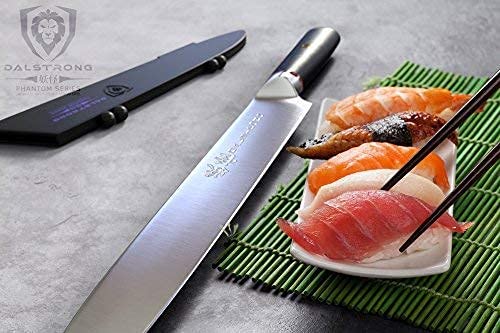
- blade length: 9.5 inches
- blade material: High-Carbon AUS8
- bevel: single
- handle: pakkawood
If you’re looking for a top-quality yanagiba knife, the DALSTRONG Yanagiba Knife is the way to go.
It’s easy to use and highly durable, and it can handle a wide variety of tasks.
This Dalstrong Phantom series blade is made with AUS8 high-carbon steel so it stays sharp and makes smooth cuts. It’s sharpened to a razor-like blade, so you never end up with rough cuts.
Sushi chefs prefer this knife because it’s perfect for skinning salmon, filleting, but also making decorative, precise cuts.
Also, the blade is narrow so you can maneuver it even when practicing complex Japanese knife techniques.
It has just the right amount of flexibility to allow for seamless slicing but it’s not prone to chipping like some cheaper knives.
The handle is made from beautiful black pakkawood, and the knife measures 9.5 inches in length.
This pakkawood handle is what makes this knife better than the competition.
It provides users with a sturdy grip but it’s also comfy to hold when cutting and slicing all day during your long shift. The handle just fits perfectly into your hand.
You have better mobility and you can fillet and slice veggies in record time. Because the knife is well-balanced, you can use it to cut out the flesh around the bones without serrated edges on the flesh.
The sharp pointed tip of the blade allows you to slice paper-thin fish fillets for sashimi in a few simple moves.
This knife looks expensive and has some elegant touches like the copper and brass mosaic pin.
Compared to Dalstrong’s Shogun series, this one is cheaper but works just as well.
The reason I picked this particular knife as a great option for chefs is that the Dalstrong knives are well crafted and have strong, hefty blades that hold the edge really well.
It’s well suited for daily use in a busy sushi kitchen and also looks very nice if you cook in front of customers.
Best value yanagiba knife: KEEMAKE Japanese VG10 Stainless Steel

- blade length: 10.5 inches
- blade material: VG10 steel
- bevel: single
- handle: rosewood
The KEEMAKE Japanese VG10 Stainless Steel Yanagiba Sushi Knife is a great choice for those who are looking for a high-quality knife at an affordable price.
This KEEMAKE knife is hand-sharpened which is quite amazing at this price point. Therefore, you can be sure it’s razor-sharp and ready to slice fish.
This knife is made with high-carbon stainless steel (VG-10) so it’s rust-proof and durable.
You’ll be surprised at how hefty it is – yet, it’s well-balanced. The thick spine makes it easier to maneuver.
Also, you’ll notice the spine is immaculately smooth – something you only see with Yoshihiro or Shun knives.
The handle is made from natural rosewood, so it’s a classic Japanese-style design. It’s smooth, ergonomic, and easy to hold.
A wooden handle might not be as durable as a pakkawood handle, but it has a nice feel in the hand and is perfect for those who are looking for an authentic Japanese yanagiba knife.
The blade measures 10.5 inches in length, so it’s great for filleting larger fish. It’s also single beveled so there’s no tearing or pulling when you slice your ingredients.
If you’re used to breaking down large fish species for fresh sushi and sashimi, you can use the yanagi after your deba to break down the flesh into bite-sized pieces.
The pointed tip is great for slicing fish but you can also use it to make precision cuts.
I think this is the kind of knife any sushi lover will appreciate. It’s good for pros but also an excellent value knife for the average home cook. Since it’s super sharp, it makes slicing tasks easy.
Overall, the KEEMAKE Japanese VG10 Stainless Steel Yanagiba is the perfect choice for anyone who wants a great knife without spending a lot of money.
It’s perfect for both beginner and experienced chefs.
Dalstrong Phantom vs KEEMAKE
If you’re a sushi chef, you need a knife you can’t count on for long shifts. Dalstrong’s Phantom series yanagiba is among the best because it has a durable blade that holds its edge.
Keemake’s value yanagi is excellent too, especially if you appreciate Japanese design features like a rosewood handle. Although it’s a good knife for chefs, it’s not as easy to maneuver.
The Dalstrong allows you to make those paper-thin fish slices over and over again without making the blade dull.
The Keemake knife is slightly longer so not quite as well-balanced as the Dalstrong. But if you’re concerned about the price, you can’t beat the value you’re getting from this Keemake knife!
Best yanagiba knife with hammered finish: YOUSUNLONG Fillet knife 12 inch Max
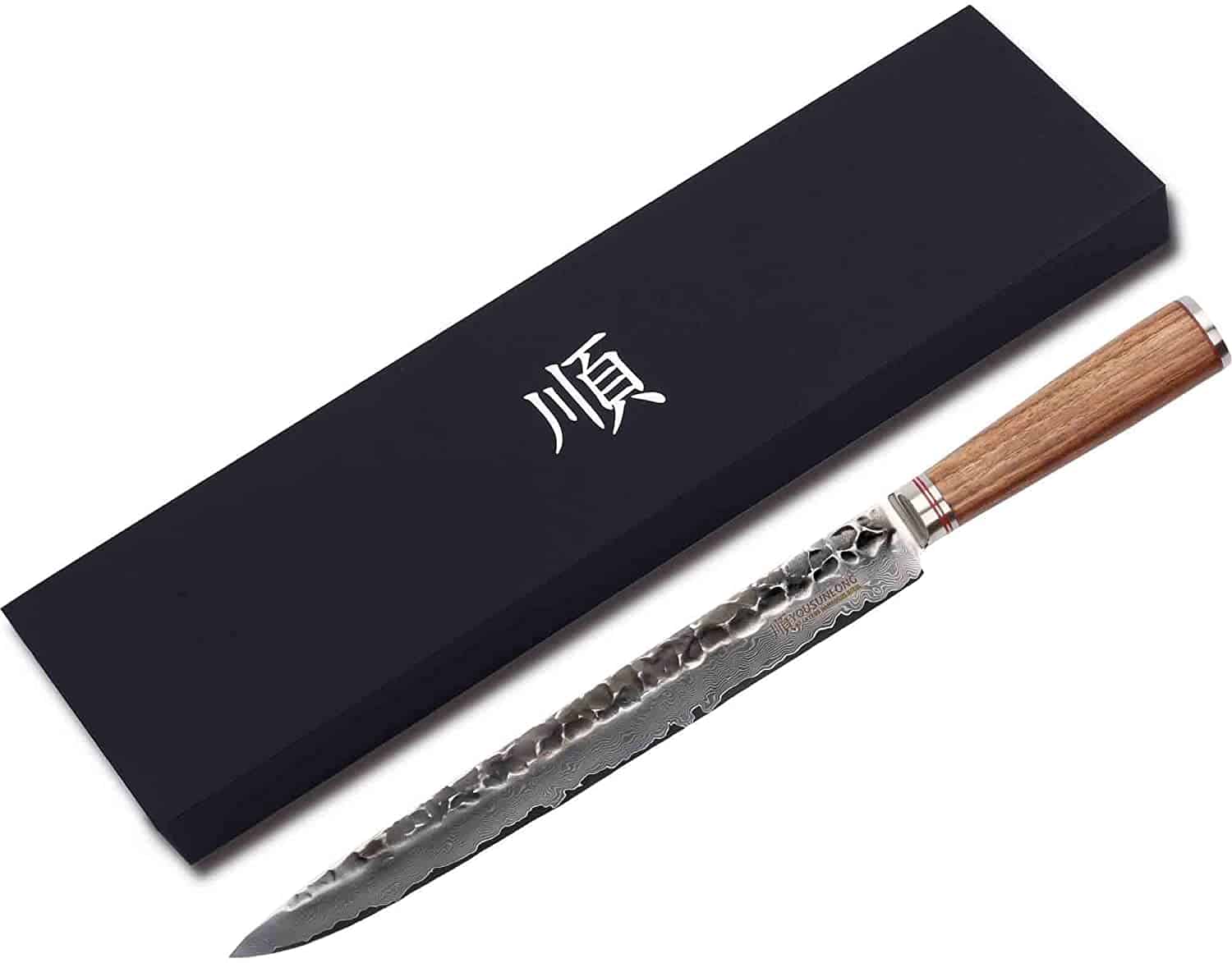
- blade length: 12 inches
- blade material: Damascus VG 10
- bevel: single
- handle: walnut wood
At 12″, the YOUSUNLONG yanagiba knife is longer than the others. It’s used by sushi chefs at busy restaurants to slice and fillet large fish like salmon and tuna.
The Damascus VG 10 steel is very durable and the blade has a hammered finish which looks beautiful.
An advantage of this hammered finish is that it cuts through sticky sushi rolls easily because the food bits don’t stick to the side of the blade.
The single bevel grind is perfect for slicing fish and other proteins.
But what I like most about this knife is the walnut wood handle. It’s comfortable to hold and it’s also very sturdy.
Generally walnut wood is a nice-looking wood but it’s a bit hard to maintain over time. The finish can start looking dull after many washes.
The YOUSUNLONG yanagiba knife is a great choice for those who are looking for a top-quality knife that can handle big jobs. It’s also well-priced and comes with a sheath for safe storage.
If you want a yanagiba knife with a hammered finish, the YOUSUNLONG Fillet knife is a great option.
This knife has a 12-inch blade and is made of high-carbon stainless steel (VG-10). The blade is also resistant to rust and corrosion.
One of the disadvantages of this knife is that compared to a blue steel handcrafted blade, it isn’t quite as sharp or well made.
However, the hammered Damascus finish gives it an aesthetic appeal that’s hard to match.
Best yanagiba knife for beginners: TUO Sashimi Sushi
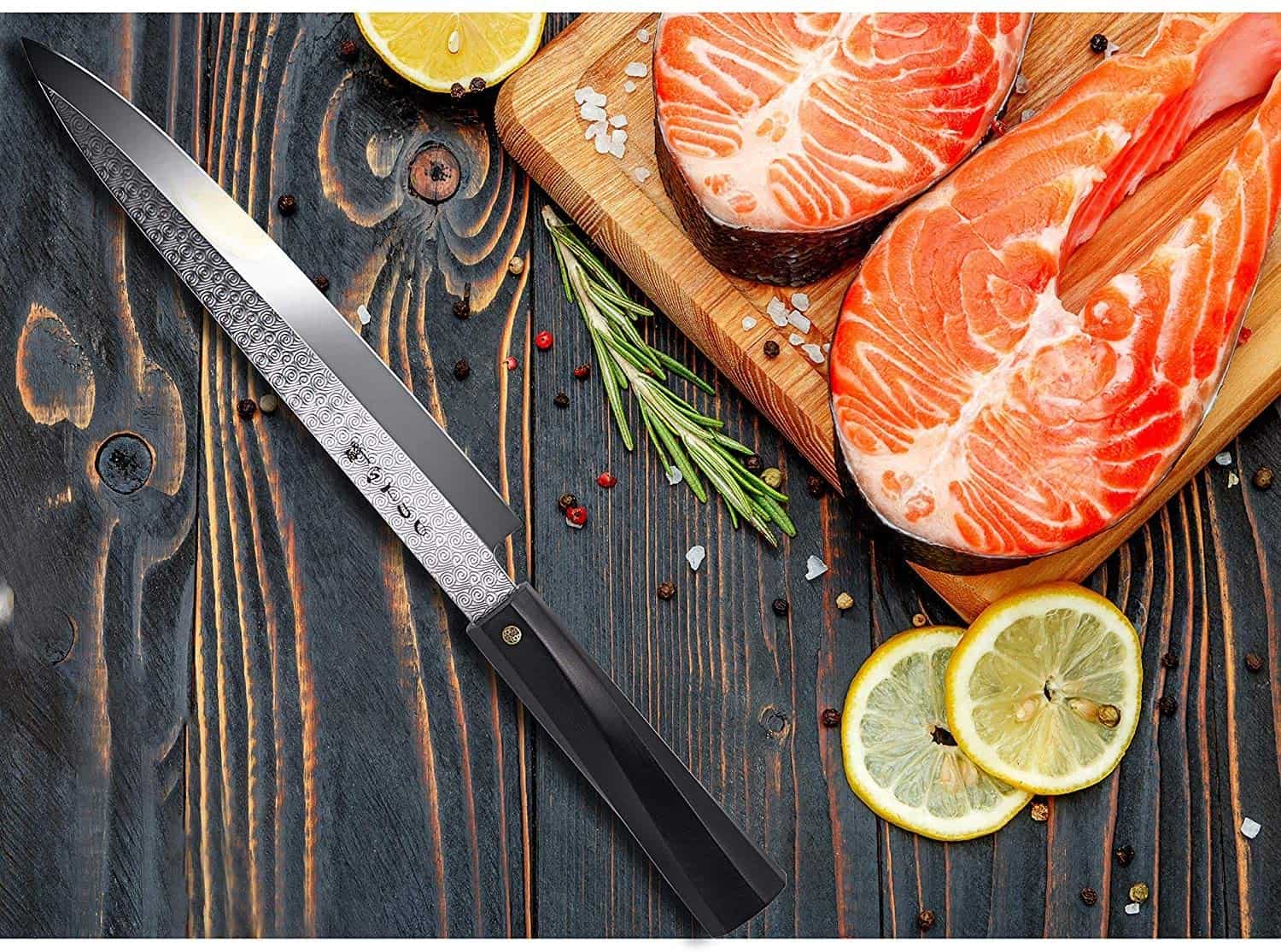
- blade length: 8.25 inches
- blade material: AUS-10
- bevel: single
- handle: G10
Do you struggle using a real yanagiba knife? Then a smaller single-bevel knife like this 8.25″ TUO is a great learning knife.
It has a G10 composite handle with a spiral shape that’s comfy and easy to hold, even if you have smaller hands. The advantage of a shorter blade is that it’s easier to make decorative cuts.
Let’s pretend you’re trying to do the katsuramuki knife technique where you peel the cucumber in a circular motion – having a shorter blade allows you to have a secure grip on the cucumber and remove enough of the peel without over-peeling.
See how to practice katsuramuki with a yanagiba here:
This knife has a G10 handle which is a type of composite material made from glass fibers and epoxy resin. It’s extremely durable and resists heat, moisture, and bacteria.
Also, this TUO knife is full-tang so it’s sturdier than many of the competing yanagiba.
The only disadvantage is that this knife is a bit hard to sharpen at home with a whetstone. It can cause minor chips in the blade, so I recommend professional sharpening for this one.
Also, compared to Dalstrong, it’s a bit duller overall but great for beginners who are afraid of cutting their fingers with a razor-sharp edge.
The AUS-10 is a high-carbon stainless steel that holds its edge well. It’s also resistant to rust and corrosion.
The single bevel grind takes some getting used to but it’s good for learning Japanese knife skills.
The TUO Sashimi Sushi Yanagiba Knife is the perfect choice for beginner sushi chefs. This knife is made with a high-carbon stainless steel blade that will last for many years.
Plus, it’s sold at an advantageous price so it’s suitable for all budgets.
YOUSUNLONG hammered vs TUO beginners knife
Both of these knives are good starter knives that can take you from a beginner to a master home chef with some practice.
If you’re looking for a top-quality knife, the YOUSUNLONG hammered yanagiba is the best option.
It has a VG-10 stainless steel blade with a Damascus hammered finish that gives it a unique look. The single bevel grind is perfect for slicing fish without the flesh sticking to the sides of the blade.
The TUO knife is smaller and easier to manipulate when you’re trying to make precise slices and cuts. If you struggle with the single bevel, you can rest assured that the TUO is easy to use.
It’s sharper than the hammered finish knife but maybe not as stylish.
When it comes to the handle, the TUO has a nice composite full tang handle whereas the hammered knife’s handle is made of wood.
This can start to decay and get moldy faster whereas the composite G10 material of TUO is more hygienic.
Best double-bevel yanagiba knife: DALSTRONG Shadow Black Series Sushi Knife 10.5″
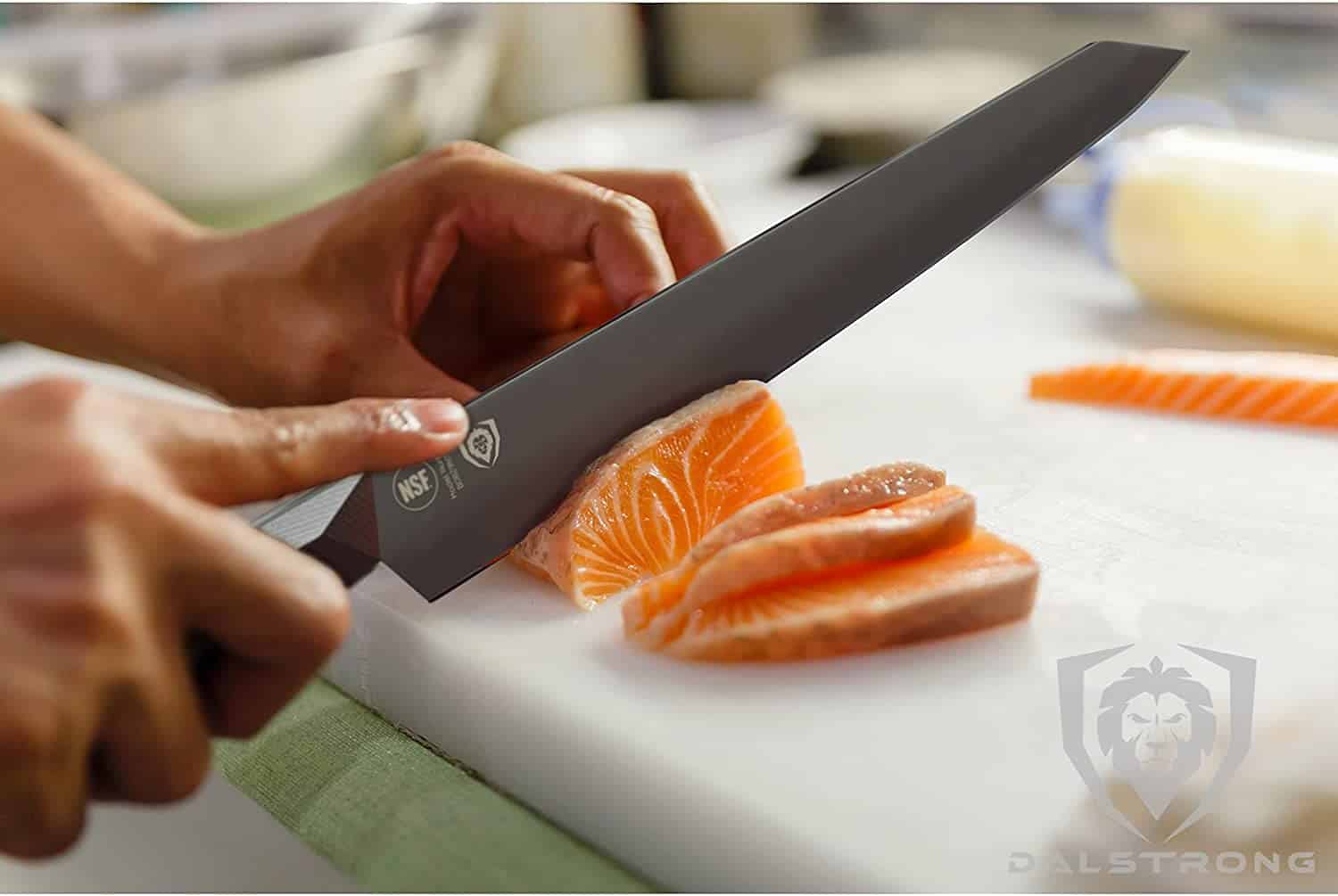
- blade length: 10.5 inches
- blade material: high carbon steel
- bevel: double
- handle: resin
Some people don’t mind using a Western type of yanagiba. This shadow black Dalstrong yanagiba isn’t quite a real yanagiba. It’s double-edged instead of single.
However, it does an amazing job when it comes to slicing fish and other fresh ingredients for sushi.
So, if you struggle with single bevel knives, or, you’re left-handed, you might be better off with this knife. It’s easier to use and still has an extremely sharp blade just like other Japanese knives.
The DALSTRONG Shadow Black Series Yanagiba Sushi Knife is a great choice for those who want a double-bevel knife.
This knife is made with a high-carbon stainless steel blade that is sharpened to a razor-sharp edge.
Just one look at this knife and you’ll be surprised how nice it looks – it has a black resin handle with a modern shape and a black blade, unlike any regular yanagi.
This knife is best known among cutlery connoisseurs as the Dalstrong with the best edge retention. So, if you’re always concerned about your blade going dull, you’ll have fewer issues with this product.
It’s suitable for use in professional kitchens, making sushi at home but also preparing all kinds of Japanese seafood dishes where you need to cut everything into small pieces or thin slices.
Compared to other Dalstrong knives, this keeps its sharpness longer.
The knife has a good balance but it’s weight-forward. However, it feels comfy in the hands.
The only issue is that the blade itself isn’t as wide as you might expect so it doesn’t keep knuckles out if you’re chopping foods like parsley or other herbs.
If you want a super-stylish knife that is sure to attract attention, this is one to add to your collection.
Best yanagiba knife for left-handed users: Mercer Culinary Genesis Forged

- blade length: 10 inches
- blade material: high carbon steel
- bevel: single
- handle: Santoprene rubber
Finding a left-handed yanagiba knife is a real challenge. Not only are the knives extremely pricey, but they can be hard to use.
Surprisingly, the Mercer Yanagiba is a good-quality leftie fish knife at a bargain price. It is 10 inches long and has a single edge designed to suit left-handed users.
Therefore, if you’re looking for a top-quality yanagiba knife that is designed for left-handed users, the Mercer Culinary Genesis Forged Yanagiba Knife is the way to go.
This knife is made with a high-carbon German steel blade and is almost as good as Japanese steel.
The handle is made from a hygienic Santoprene which prevents bacteria and mold build-up.
The Mercer Culinary Genesis Forged Yanagiba Knife is the perfect choice for beginner and professional chefs alike. It’s easy to use and highly durable, and it can handle a wide variety of tasks.
Customers who are looking for budget-friendly leftie knives are often stuck between choosing this Mercer or the Dexter knife.
However, when it comes to overall performance and build, the Mercer is better. It’s not as flimsy or cheap looking and the blade doesn’t wiggle at the handle section.
This blade is razor-sharp so you can expect the blade to slice through the fish with ease. Using this knife is smooth like butter, you won’t end up with any tears or rips in the flesh.
Thus, it’s a perfect knife if you want to make restaurant-grade sushi rolls at home.
Plus, it can even cut through the sticky rice and Nori paper in one smooth movement.
Be careful how you store this yanagiba knife though since the blade is prone to chipping. As you would expect at this price point, the steel isn’t as well forged as a $300 Shun or Sakai knife.
But, for the ambitious left-handed home sushi chef, this Mercer knife has all the necessary features.
Dalstrong Shadow double-bevel vs Mercer left-handed yanagiba
The Dalstrong double bevel is the universal sushi knife for lefties and righties. Since it’s double-edged, it’s more versatile and can be used for all kinds of cutting tasks, not just fish.
Mercer’s yanagiba knife is specially designed and crafted for left-handed users. It’s a great knife but it doesn’t offer the same level of versatility as the Dalstrong.
When it comes to sharpness, both knives are extremely sharp out of the box. However, the Dalstrong holds its edge for longer and is easier to sharpen.
The Dalstrong also has a better-balanced blade which makes it worth the extra dollars.
But, if you are a leftie, you definitely need to use the Mercer knife – it’s still amazingly sharp and will help you execute any kind of filleting and slicing job for tasty homemade sushi and sashimi.
Dalstrong’s resin military-grade G10 handle is more resistant to daily wear and tear but at least the Mercer knife’s Santoprene rubber handle doesn’t slip from your hand.

- blade length: 11.8 inches
- blade material: shirogami steel
- bevel: single
- handle: magnolia wood
Japanese knife experts know that some of the world’s best blades are forged in Sakai. This premium Honmamon Motokane knife is one of the unique traditional yanagibas.
It’s made of white paper steel and forged to perfection. Therefore it’s one of the sharpest and best single bevel sushi knives out there.
I highly recommend this knife for serious sushi chefs or those on the path to becoming sushi chefs. It’s got a hefty price tag but this knife will last a lifetime if it’s maintained properly.
The knife has a traditional magnolia wood handle and an octagonal handle shape which is a bit harder to work with for beginners, but the pros understand that it doesn’t get much better than this.
You can easily slice, chop, fillet, mince, and dice all kinds of sushi ingredients. If you like to work with eel, you can also use it to cut chewy meats in a couple of strokes.
This Motokane yanagiba has a bit of a rough finished appearance but don’t worry – that’s just because it’s handmade, not machine-made.
When it comes to durability, sharpness, and overall build, it’s hard to beat.
Sakai knives traditionally have a rustic or rough finish to them and this knife is just like that. This one is even more so since it’s fully hand-crafted.
Any tiny imperfection is proof this blade was forged out of high-quality Japanese white paper steel.
This knife is sold with a matching sheath to protect it in storage.
If you’re looking for a top-quality yanagiba knife, the MOTOKANE Shirogami Steel Sashimi Hocho Yanagiba Knife is a great option.
The blade is also sharpened to a 16-degree angle, so it’s capable of making precise cuts.
Best yanagiba knife for sashimi: Sakai Takayuki Hammered Damascus

- blade length: 11.8 inches
- blade material: white steel
- bevel: single
- handle: natural wood
No yanagiba review is complete without the Sakai Takayuki Yanagiba. If you want to try a handcrafted sushi knife from Sakai city, this one is of amazing quality and still sold at a fair price.
It’s often compared to the Yoshihiro yanagi knife which is also a good sashimi blade. However, the Sakai seems to hold up well over time and keeps its edge sharp slice after slice.
The slicing experience is so smooth, you’ll be using it for all kinds of cutting tasks involving raw fish.
There are no rips or tears in the fish flesh and you can dice or cube even thicker, bigger, and oilier fish. When needed, you can make the fish paper-thin and ready to serve as sashimi.
This knife is made with a high-quality white steel blade that is sharpened to a razor-sharp edge.
The handle is made from beautiful natural wood and the knife measures 11.8 inches in length.
The Sakai Takayuki Yanagiba is the perfect choice for those who want a top-quality knife without breaking the bank. It’s easy to use and highly durable, and it can handle a wide variety of tasks.
Since craftsmen handmake each knife, the attention to detail is amazing! There are no rough finishes, edges, or small imperfections here. The whole knife is smooth from handle to tip.
Compared to Western knives like Wusthof, the blade is thinner at the top which makes it easier to slice through fish. It binds less, makes smoother cuts, and takes less effort than using a regular chef’s knife.
The only drawback of this knife is that it’s not dishwasher safe, so you’ll need to handwash it after each use.
But, considering the outstanding quality, I think this is a small downside.
Motokane vs Sakai
It’s hard to find fault with these two premium yanagiba knives. You can use either for all fish slicing tasks.
If you’re more into sushi knives, I like the Motokane because its blade is a bit thicker. But, if you need absolute precision and want a sashimi knife that doesn’t let you down, go for the Sakai.
When it comes to premium products, these two are the best sushi knives. Both are handcrafted by skilled tradesmen in Sakai.
The major difference is the price. As with all traditional Japanese knives, these products are much more expensive than the average kitchen knife.
However, you can be sure you’re getting the best single edge blade from Motokane. If you are filleting fish, you will feel the difference when using Motokane compared to a cheaper knife like the JapanBargain.
Sakai is also a good brand of expensive sushi knives, so you can count on the knife to last a lifetime.
This knife features a narrow blade and octagonal handle which is something a professional sushi chef expects.
Best yanagiba sushi knife with holes: JapanBargain 1551 Non-Stick Sashimi Knife

- blade length: 7.87 inches
- blade material: Molybdenum steel
- bevel: single
- has holes
- handle: wood
If you’re wondering why this sushi knife has holes, then you’re not alone. This type of yanagiba is not as popular in America and Europe as it is in Japan.
The holes in a sushi knife are designed to reduce the weight and drag of the blade through the fish, which makes it easier to cut smoothly.
Holes are practically air gaps that prevent the sticky ingredients like fish flesh, meat, avocado, and sticky rice (just to name a few) from sticking to the sides of the blade.
If you want to make faster cuts and reduce filleting and sushi prep time, get the JapanBargain 7.8 inch yanagiba knife.
So, are the holes really necessary? Well, not really but they do make the blade non-stick so you can slice fish faster.
JapanBargain’s yanagi is a cheaper knife but it still has a sharp edge and Molybdenum steel blade. This Japanese material is corrosion and rust-resistant.
The knife has a sturdy handle and feels well-balanced when you hold it.
Since the blade has holes, the knife takes longer to clean and wipe down between uses. Also, you shouldn’t wash this knife in the dishwasher or else it gets damaged, especially at the wooden handle part.
Unfortunately, some people noticed some chipping on the blade, especially if you try to use this Yanagi for cutting vegetables or thick meat. Make sure to use it for its intended purpose.
Overall, users are saying this knife is a good value purchase because it’s pretty nice quality and an ideal starter knife for sushi lovers.
Takeaway
A great sushi knife must have an extremely sharp blade and if it’s a single bevel blade, it’s even better!
The Imarku Yanagiba Knife has a long, thin high carbon steel blade that’s very sharp, making it a fantastic knife for precision slicing. It’s a good sushi knife for amateur and pro chefs alike.
Now that you know what to look for in yanagiba sushi knives, you can create appetizing and delicious sushi and sashimi at home.
Trust me, the yanagiba beats out other knives and ensures you can slice through raw fish without tearing through the flesh.
Next, don’t let the Honesuki Japanese boning knife miss in your Japanese knife collection
Check out our new cookbook
Bitemybun's family recipes with complete meal planner and recipe guide.
Try it out for free with Kindle Unlimited:
Read for freeJoost Nusselder, the founder of Bite My Bun is a content marketer, dad and loves trying out new food with Japanese food at the heart of his passion, and together with his team he's been creating in-depth blog articles since 2016 to help loyal readers with recipes and cooking tips.
